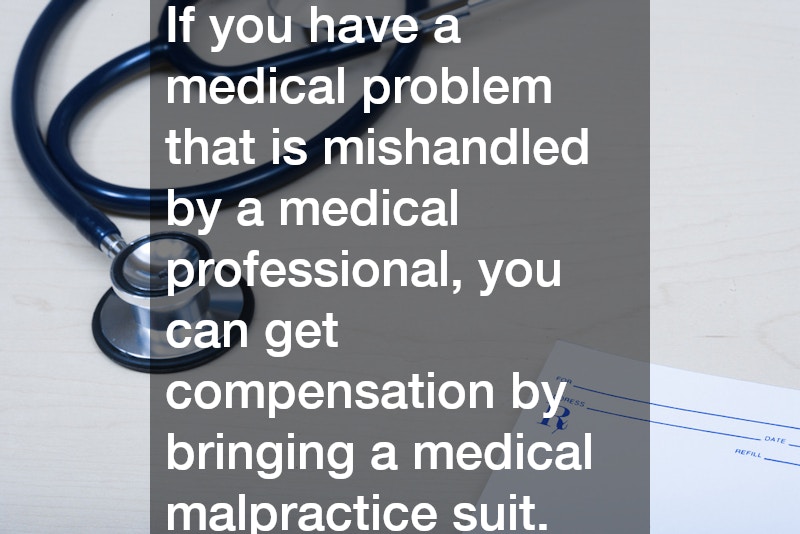
If you have a medical problem that is mishandled by a medical professional, you can get compensation by bringing a medical malpractice suit. To know whether your situation is appropriate for charges of medical malpractice, you’ll need to consult a medical malpractice attorney. These lawyers have medical knowledge as well as legal expertise, and they can tell you if your situation applies.

When you first contact a medical malpractice lawyer, they will listen to the details of your case. They will gather information about your condition and what has happened to warrant a malpractice charge. According to Forbes, you must prove you were under the care of a physician (or another health care professional). You’ll need documentation from the medical facility where you were treated.

According to Forbes, the next thing to prove is that the physician made a breach of the standard of care in your case. Medical experts will describe the professional standard of care for your procedure. Your lawyer will explain that for medical malpractice standard of care is subject to interpretation. According to the Expert Institute, most cases are decided according to what a “reasonable physician” would do.
Breach of Standard of Care
Medical malpractice leads to many lifelong disabilities and deaths. Although estimates vary widely, the number of Americans who die from medical malpractice every year could be anywhere from 15,000 to 225,000.
Medical malpractice is a major cause of death and, if the high estimates are correct, the third leading cause of death in the U.S. Many more victims of medical malpractice could suffer chronic disabilities or severe injuries for the rest of their lives. For example, when a hospital mistakenly amputates the wrong leg, there is nothing that the hospital can do to replace the leg.
Medical malpractice can be difficult to understand for non-lawyers, however. As a result, you should always consult with a lawyer if you believe your injuries were the result of medical malpractice. With that said, here are a few facts to understand about medical malpractice claims so you know the issues you can raise with medical malpractice attorneys you speak to:
Medical Malpractice is Negligence
One of the most important facts to understand about medical malpractice is that it is no different from any other negligence claim. In other words, suing a doctor for professional negligence is no different from suing a driver who ran a red light or a grocery store that failed to clean up a spill.

The elements of a negligence claim include:
- Duty: The person causing the injury must owe a duty to the injured person. A doctor, nurse, hospital, dentist, and other healthcare providers owe a duty to the patients under their care to provide reasonable medical care under the circumstances.
- Breach: The injured person must prove that the duty was breached. When a lawsuit is about medical malpractice, the breach occurs when the care provided was unreasonably deficient in some way. For example, if a patient requires cataracts treatment after botched corrective eye surgery, the duty to provide reasonable care was probably breached.
- Causation: The breach must be the cause-in-fact and proximate cause of the injuries or death. “Cause-in-fact” means that the breach is in the chain of events that led to the injury. “Proximate cause” means that the injuries are the foreseeable result of a breach of duty. Both of these are explained in more detail below.
- Damages: The breach of duty must result in damages to the victim. In other words, if medical malpractice did not change the outcome of the patient’s disease, there are no damages. For example, if a patient is not rotated for two days, but does not develop bedsores or other adverse outcomes from the nurses’ failure, there are no damages despite the clear breach of established protocol.
Medical Malpractice Is not Limited to Doctors
Any healthcare provider can commit medical malpractice. Some examples of entities and people who need to be wary about medical malpractice claims include:
- Doctors: Medical doctors, regardless of specialty, are subject to medical malpractice claims. Even doctors that do not directly interact with patients, like radiologists who merely read images, can commit medical malpractice if their standard of care does not meet the reasonableness standard.
- Dentists: Like medical doctors, dentists and orthodontists are subject to medical malpractice lawsuits for the dental and orthodontic treatment they provide.
- Nurses: Even without the expansive responsibilities that doctors have, nurses do provide medical care and can be sued for malpractice if the care is unreasonably deficient.
- Hospitals and medical centers: Hospitals are responsible for their policies and employees. If a hospital’s employee commits medical malpractice, the hospital is usually responsible. Similarly, if a hospital’s policies result in inadequate care, the hospital may be subject to a medical malpractice lawsuit.
- Therapists: Since they exercise professional judgment in providing physical or mental therapy, physical therapists, mental health therapists, psychologists, and counselors may be sued for professional malpractice.
- Pharmacists: Pharmacists can be subject to medical malpractice claims if they fail to provide adequate care in providing medication. This is the reason good pharmacists always speak to you about when and how to take medication and possible side effects.
- Medical laboratories: Medical labs can commit malpractice in a number of ways including mixing up test results, running or interpreting a test incorrectly, or losing a test sample.
Medical Equipment and Device Manufacturers Are Usually Not Subject to Malpractice

In most cases where medical equipment or medical devices are defective, a lawsuit would allege product liability rather than medical malpractice. In other words, even if the equipment or device was recommended or even prescribed by a doctor, a failure of the device does not bring about medical malpractice claims. Instead, the claim would be filed as a product liability claim against the manufacturer.
Product liability is different from medical malpractice because product liability is “strict liability” rather than negligence. This means that the mindset of the manufacturer is irrelevant to proving liability.
To prove a product liability case for medical equipment, pharmaceutical product, or a medical device, an injured person has three options:
- Design defect: A product has a design defect if it has no safe use. An example of a product with a design defect was the drug thalidomide. This drug was prescribed to pregnant women for morning sickness but resulted in birth defects. This product had no safe use.
- Manufacturing defect: A manufacturing defect exists if a product can be used safely, but has been manufactured in a way that prevents its safe use. For example, most hearing aids are manufactured using special processes to eliminate all moisture from the hearing aid. However, a hearing aid that is manufactured in a way that retains moisture inside the device, a wearer can suffer from ear infections or worse.
- Warning defect: A warning defect occurs when the manufacturer fails to provide instructions or labels that warn users from dangerous uses of the product. For example, lift chairs have many moving parts and powerful motors. If a manufacturer fails to label areas where a hand could be crushed, a user might be able to sue the manufacturer for product liability.
Medical Malpractice Can Take Many Forms
When you speak to a lawyer, you will need to explain all the facts about medical malpractice you experienced. This includes explaining how the care you received failed to meet the standard of reasonableness.
Some of the ways medical malpractice lawyers can prove negligence include:
- Diagnosis error: When a healthcare provider makes an incorrect diagnosis, the misdiagnosed patient could be the victim of medical malpractice. This error can take a few different forms including diagnosing a patient as normal while they actually have a condition or disease, diagnosing a patient with the wrong condition or disease, or diagnosing a patient as having a condition or disease while they are actually fine. This error can be particularly risky for radiologists and medical labs.
- Treatment error: A treatment error occurs when a medical provider fails to provide a reasonable level of treatment to the patient. Most non-lawyers would immediately think of treatment errors when they hear the phrase “medical malpractice.” Examples of treatment errors include botched foot surgery that causes the foot’s arch to collapse and requires flatfoot reconstruction to fix.
- Communication error: A communication error occurs when a medical provider fails to provide the patient with adequate correct information to make an informed decision. Thus, if a doctor fails to warn a patient of a known side effect of a treatment, or provides false or misleading information about a known side effect, the doctor may have committed medical malpractice.
Medical Malpractice Cases Start With Insurance Companies

When you meet with a personal injury lawyer about medical malpractice, the lawyer will evaluate the case, then send a letter to the healthcare provider accused of malpractice. The healthcare provider will refer the letter to their malpractice insurer. From this point forward, all communication about medical malpractice in your case will be between your lawyer and the healthcare provider’s insurance company.
To determine whether it is legally obligated to pay your claim, the malpractice carrier will investigate what happened. To move this process along, your lawyer will send copies of your medical records and may also provide a second opinion from a doctor that identifies the deficiencies in the care you received.
In many cases, the malpractice carrier will deny your claim. When this happens, you will need to fight the insurance company in court by filing a medical malpractice lawsuit. Malpractice lawsuits can take a long time to resolve because insurance companies know that it is usually cheaper to fight the lawsuit rather than paying for your damages. Moreover, malpractice lawsuits often require expert witnesses for both sides who testify about the reasonableness (or unreasonableness) of the medical care you received.
Insurance companies also know that the longer the case takes, the more likely a patient is to quit. As a result, the average successful medical malpractice cases take about 17 months to win.
Damages to Expect in a Medical Malpractice Case
Under the law, you are entitled to claim a few different forms of damages, including
- Compensatory damages: These damages compensate you for your expenses and costs that resulted from the medical error. These include medical bills and out-of-pocket expenses you paid. For example, if you needed corrective surgery and had to install a wheelchair ramp after a surgeon botched your knee surgery, those expenses could be claimed as damages. Keep in mind, however, that injured patients are not allowed to “double dip.” This means that any expenses for which you are already compensated (such as corrective surgery paid for by your health insurance) cannot be included in your damages.
- Consequential damages: Any expenses that flowed from the medical error can also be claimed as damages. Lost wages, pain and suffering, and lost earning capacity are examples of consequential damages. For example, if you worked as a long-haul truck driver and medical malpractice left you unable to sit for long periods of time without pain in your neck and back, you might be able to claim both your lost wages while you recovered from the malpractice as well as your lost earning capacity in the future since you can no longer drive trucks. Again, no double-dipping is allowed, so you may want to consult your disability lawyer if your injuries are compensated by social security disability benefits or VA disability benefits.
- Punitive damages: Punitive, or exemplary, damages are used to punish the healthcare provider. They are only granted in especially egregious cases. For example, in a notorious case, a doctor carved his initials into a patient after surgery. That case settled, but would have been a prime case for punitive damages.
You can receive compensation for medical malpractice in two ways. If the insurance company determines that it might lose at trial, it may try to settle the case. As your lawyer negotiates with the malpractice carrier, the lawyer will use evidence of your damages to try to squeeze the carrier for a fair settlement offer.
If you go to trial, all the evidence about medical malpractice damages will be presented to a jury. The jury will use this information to calculate a damages award if you win your case.
Situations That Might Not Be Medical Malpractice

Although you can find many examples of medical malpractice, online resources are often less clear about what is not medical malpractice. You should bear in mind that you should always talk to at least one law firm about your case to determine whether you have a claim for malpractice against your healthcare provider. However, many common situations might not support a winning case. For example:
- Bad outcome: Medical malpractice does not exist merely because you did not get the outcome you expected. If a doctor warns you of risks and potential negative outcomes and you gave informed consent, it may be difficult to complain about medical malpractice. For example, if you undergo plastic surgery, you might not be able to sue the doctor just because you are disappointed in the outcome.
- Unknown risks: If a doctor performs a treatment and an unknown effect occurs, medical malpractice might not have occurred. Negligence requires a failure to provide reasonable care and if the doctor reasonably believed the treatment was safe under the circumstances, you might not be able to provide malpractice.
- Not a patient: The duty owed by a healthcare provider is established by a doctor-patient relationship. If the relationship has not been established, you might not be able to sue the doctor for malpractice. For example, if you follow the advice of a doctor you see on television or who has written a book, without actually consulting the doctor, you probably cannot complain about medical malpractice if things go wrong. Similarly, if you have a heart attack on an airplane and a doctor volunteers to keep you stable until the plane lands, the emergency nature of the treatment might mean that you were not a patient who can sue the doctor for malpractice.
The theory that supports medical malpractice claims is not difficult to understand. However, the science and medicine that underlie malpractice claims make the theory difficult to apply in practice. You should always consult a few different lawyers to evaluate your medical malpractice case. One lawyer might see a path to a case when another does not.
Moreover, different lawyers approach the fees for medical malpractice cases differently. By shopping around, you might find the right mix of fees, knowledge, experience, and skill for your case.


